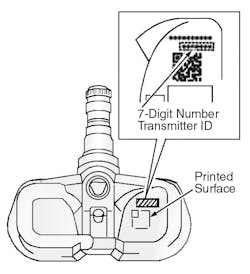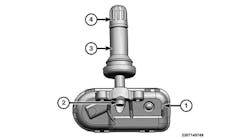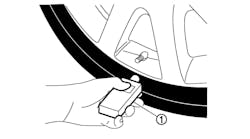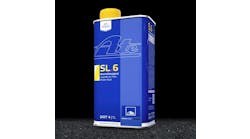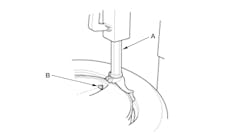SUBJECT VEHICLES: Toyota 2006-2012 RAV4
RELEARN PROCEDURE? Yes.
SPECIAL TOOLS NEEDED? Yes, a Toyota Techstream.
The tire pressure monitoring system (TPMS) of the 2006-2012 Toyota RAV4 is designed to provide warning when tire inflation pressure of one or more tires (including the spare tire) is low. A tire pressure monitor valve sub-assembly equipped with a tire pressure sensor/transmitter is installed in each tire and wheel assembly.
The sensor measures the air pressure and internal temperature of the tire, then the measured values and transmitter ID are transmitted to the tire pressure monitor antenna and receiver assembly on the body as radio waves. These radio waves are then sent to the tire pressure monitor engine control unit (ECU) from the tire pressure monitor receiver. If the transmitter ID has already been registered, the ECU compares the measured air pressure value and the standard value. When the value is less than the standard value registered in the tire pressure monitor ECU, the tire pressure warning light on the instrument cluster will turn on.
Under the following conditions, the system may not function properly:
- The areas, facilities or devices that use similar radio wave frequencies are located in the vicinity of the vehicle.
- A radio device of similar frequency is used near the vehicle.
- A lot of snow or ice is stuck to the vehicle, especially around the wheels or wheel housings.
- Tires and wheels are installed that are not equipped with a tire pressure sensor.
- Snow tires or tire chains are used.
- The battery of the sensor has been depleted.
- Wheels other than manufacturer factory wheels are used. If any other wheels than the specified ones are used, the system may not function properly because the radio waves are differently transmitted from the tire pressure sensor.
- Radio waves from the air pressure sensor installed on the spare tire cannot be received. If this problem has occurred, rotate the spare tire 90 degrees and recheck the system.
- Depending on the tire type, the system may not function properly even though the specified wheels are used.
- Using a different type of tire in combination with the original tires.
- If the system was initialized with tire pressures which are not the specified values.
Tire pressure monitor warning light
NOTE: The tire pressure warning light may turn on due to natural causes such as natural air leaks or tire pressure changes caused by temperature. In this case, adjusting the tire pressure will turn off the warning light.
NOTE: If the warning light turned on due to very low outside temperatures (such as in winter) causing decreases in tire pressure, adjust the pressure to a higher pressure suitable to cold conditions.
Tire pressure decreases by about 1.45 psi (10 kPa) for every 50 degrees Fahrenheit (10 degrees Celsius) drop in ambient temperature.
When the tire pressure warning light does not go off, or when it comes on during driving, tire pressure (including the spare tire) must be checked and adjusted as necessary. The warning light should turn off within a few minutes. If the warning light is still on even though the tire pressure is correctly adjusted, the tire could be punctured. Repair as necessary. If the warning light turns on within several hours after adjusting the tire pressure, the tire may have a slow air leak. Repair as necessary. If the warning light stays on or blinks, there is a malfunction in the TPMS. See appropriate manufacturer service information.
Reset procedures
NOTE: When a tire pressure sensor and/or tire pressure monitor ECU are replaced, the sensor ID must be memorized (registered) by the tire pressure monitor ECU.
When the tire pressure warning light does not go off, or when it comes on during driving, check tire pressure (including the spare tire) and adjust as necessary. The warning light should turn off within a few minutes.
Tire pressure sensor registration
NOTE: When a tire pressure sensor and/or tire pressure monitor ECU are replaced, the sensor ID must be memorized (registered) by the tire pressure monitor ECU. To perform this procedure, a Toyota Techstream must be used. It is not necessary to register the sensor IDs when only tire rotation is performed.NOTE: Before beginning the registration process on vehicles where tire pressure sensors have not been replaced, retrieve sensor transmitter IDs using Techstream or by reading the ID on the tire pressure sensor. If a sensor is being replaced with a new one, make a note of the seven-digit number (transmitter ID) before installation, as it cannot be seen after the sensor is installed (see Figure 1).
1) Set the tire pressure of all the wheels (including the spare tire) to the pressure specified on the tire and loading information label.
2) With the ignition OFF, connect the Techstream to DLC3.
3) Turn the ignition switch to the ON position.
4) Enter the following menus: Chassis / Tire Pressure Monitor / Utility / ID Registration.
5) Perform the procedures displayed on the screen.
NOTE: It may take up to about two to three minutes to update the tire pressure data. If the values are not displayed after several minutes, perform troubleshooting according to the inspection procedure for DTCs C2121/21 to C2125/25. If the IDs have not been registered, DTC C2171/71 is set after three minutes or more.
6) Confirmation of transmitter ID registration:
- a) Enter the Techstream menu items in this order: Chassis / Tire Pressure Monitor / Data List.
- b) Confirm that the expected tire pressures of all tires are displayed on the screen.
Demounting/mounting procedures
CAUTION: The tire should be demounted from the wheel using the tire changer manufacturer’s instructions. Use the following information to avoid damage during the demounting/mounting procedures.
NOTE: When a tire pressure sensor and/or tire pressure monitor ECU are replaced, the sensor ID must be memorized (registered) by the tire pressure monitor ECU. See reset procedures.
NOTE: The TPMS is not affected by wheel and tire rotation.
Tire pressure sensor
CAUTION: DO NOT try to install a tire pressure sensor in a steel wheel or aftermarket wheel. Due to the unique air valve angle of the tire pressure sensor, use only in original style factory wheels.
CAUTION: The use of tire sealants is strictly prohibited for vehicles equipped with TPMS. Tire sealants can clog tire pressure sensors.
CAUTION: Be sure to reinstall tire valve caps, or dirt or moisture could get into the valve core and cause air leakage. Use only the original valve cap. If any other valve cap is used, it may corrode or melt, and become extremely difficult to remove.
NOTE: The average life of the grommet of the tire pressure monitor valve sub-assembly is approximately five years, at which time it must be replaced. If the valve is leaking air, but it is less than five years old and the grommets are in good condition, retighten the valve nut to 35 in.-lbs. (4 N.m). Whenever the tires must be replaced, replace grommets for tire pressure sensors as well. Whenever a new sensor is installed, it will need to be registered in the tire pressure monitor ECU.Removal
1) When replacing a wheel or tire, tire pressure sensors must be set up in one of the following ways:
- Remove the sensor from the old wheel and install it to the new wheel.
- Keep the same wheel with tire pressure sensor, and replace only the tire.
- Use a new wheel and sensor (the new sensor must be registered after installation).
2) Remove the wheel. Remove the valve core and cap, and release air from the tire (see Figure 2). Keep the removed cap, valve core, nut and washer.
3) After ensuring that air is sufficiently released, remove the nut and washer that is used to fix the tire pressure monitor valve sub-assembly and drop the sensor inside the tire. Be careful not to damage the tire pressure monitor valve sub-assembly due to interference between the sensor and tire bead.4) After dropping the tire pressure monitor valve sub-assembly into the tire, disengage the bead using the shoe of the tire remover (see Figure 3).
5) Remove the bead on the upper side in the usual operation.
6) Take out the sensor from the tire, and remove the bead on the lower side as in usual operation.
NOTE: Check that no cracks or damage is identified on the grommet. If so, replace the grommet together with the washer and nut.
7) Remove the inner grommet from the tire pressure monitor valve sub-assembly.
NOTE: The tire pressure sensor is powered by a lithium battery. When disposing the sensor, remove the battery and dispose of properly.
Installation
1) Insert the tire pressure monitor valve into the valve installation hole. Insert from the inside of the rim so that the print surface can be seen (see Figure 1). Check for the following:
- Check that there is no visible deformation, damage or other abnormalities on the transmitter.
- Check that there is no foreign matter on the inner grommet and around the rim hole.
- If installed in the reverse direction, the tire pressure monitor valve may be damaged or fail to transmit signals when running at high speed.
- As noted, if installing a new tire pressure monitor valve, write down the ID number before installation (see Figure 1). It is necessary to register an ID in the ECU after installation.
2) Install the washer on the tire pressure monitor valve from the rim side, and tighten the nut to 35 in.-lbs. (4 N.m), see Figure 4. Check for the following:
- Ensure there is no foreign matter on the washer and nut. If the tire pressure monitor valve was removed, check that there is no damage or cuts, and no foreign matter such as mud, dirt or sand is attached to the grommet. Replace the grommet with a new one if any of these defects are found.
- Check that there is no oil, water or lubricant around the rim hole, tire pressure monitor valve, washer and nut. Failing to do so may result in improper installation.
NOTE: The specified torque only applies to the first time washer is used.
3) After the tire is inflated, the valve nut may be loose. Retighten the nut to the specified torque, and then check for air leaks with soapy water.
CAUTION: If the sensor is positioned outside this area, it generates interference with the tire bead, causing possible damage to the sensor.4) Set the wheel disc to the mounting machine, and install the lower tire bead. Position the main body of the sensor in the shaded area as shown in the illustration (see Figure 5).
5) Making sure that the tire bead and tool do not interfere with the main body of the sensor and that the sensor is not clamped by the bead, install the upper bead.
6) When putting air into the tire, first install the tire pressure valve straight on the stem of the tire pressure warning valve and transmitter.
7) Install the tire and wheel assembly.
8) When a new sensor is installed, the ID code will need to be registered. See tire pressure sensor registration under reset procedures.
9) After completing the operation, remove the valve core to rapidly release the air in the tire. Ensure that the tire pressure warning light comes on. If the warning light does not come on, refer to the appropriate manufacturer service information.
10) If there is an air leakage, tighten the nut to a force of 35 in.-lbs. (4 N.m), and push the valve core two to three times to remove any dirt attached to the valve core. If air continues to leak, replace the grommet, washer and nut.
Torque specifications
Component Ft.-lbs. (N.m)
Wheel nut 76 (103)
In.-lbs. (N.m)
Tire pressure sensor nut 35 (4)
Information for this column comes from Mitchell 1’s “Tire Pressure Monitoring Systems Guide” for domestic and import vehicles. Headquartered in Poway, Calif., Mitchell 1 has provided quality repair information solutions to the automotive industry for more than 80 years. For more information, visit www.mitchell1.com.
To read more TPMS columns, click:
2007-13 Chrysler/Jeep Compass and Patriot
TPMS: General Motors/Chevrolet Colorado and Canyon, 2006-12
2011-2015 Chrysler Ram Pickups
